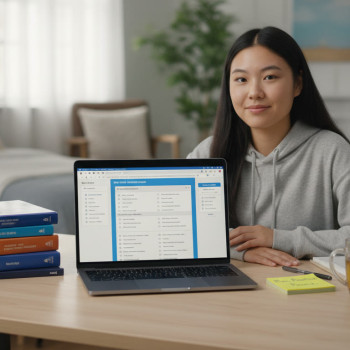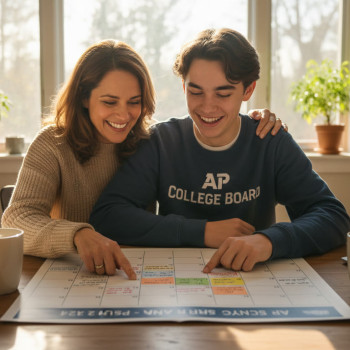Why Sciences Po and Why a Social-Science Focus?
Sciences Po is more than a name in global higher education—it’s a gateway to public affairs, international relations, political science, economics, and public policy. For students in the U.S. preparing through the AP (Advanced Placement) program, a deliberate combination of AP courses and demonstrable social-science interest can make an application resonate with selectors at Sciences Po and similar institutions.
This blog is written for students and parents who want an intelligent, practical plan: which APs to choose, how to show intellectual curiosity beyond grades, what admissions officers look for, and how to balance academic rigor with meaningful extracurriculars. You’ll also find concrete study strategies, sample timelines, a compact table to help plan course loads, and realistic advice about essays, interviews, and test strategy. Along the way I’ll mention how Sparkl’s personalized tutoring—1-on-1 guidance, tailored study plans, and expert tutors with AI-driven insights—can fit naturally into your preparation.
How AP Courses Signal Readiness for Social-Science Study
AP courses demonstrate rigorous academic preparation recognized by colleges globally. For a student aiming at Sciences Po, AP classes do two important things:
- Show mastery of content relevant to social sciences (history, economics, government, statistics).
- Indicate readiness for college-level thinking and research through essays, source analysis, and data interpretation.
Best AP Picks for a Social-Science Track
Not all APs are created equal for a social-science-focused profile. Below are high-impact options and why they matter:
- AP European History: Deep context for modern Europe—excellent for applicants to institutions with strong European focus like Sciences Po.
- AP United States History (APUSH): Teaches evidence-based argumentation and comparative historical thinking.
- AP Government and Politics (Comparative and/or US): Directly maps to political science foundations.
- AP Macroeconomics and AP Microeconomics: Cover core economic principles that underpin public policy and international relations.
- AP Psychology: Helps understand human behavior—a growing asset in policy and political analysis.
- AP Statistics: Essential for empirical social science work and research methods.
- AP Language or AP Literature: Strengthen communication and analytical writing—critical for essays and interviews.
How To Sequence These APs Over High School
Think strategy, not overload. A thoughtful sequence shows sustained interest and balance.
- 10th grade: Start with AP World History or AP European History (if available) and AP English Language if you’re ready; introduce AP Psychology or AP Statistics if you’re inclined to data or behavior.
- 11th grade: Aim for AP United States History or AP Comparative Government, plus one economics AP. Junior year is when GPA and AP scores carry the most weight.
- 12th grade: Take advanced or complementary APs like AP Microeconomics, AP Macroeconomics, or AP Literature; use senior seminars or independent study to deepen a specific interest tied to your application theme.
Building a Compelling Academic Narrative
Colleges like Sciences Po look for coherent narratives—meaning they want to see intellectual curiosity that follows a theme. The AP course list should echo that theme. Here’s how to craft a narrative rather than merely racking up AP credits.
Start with a Central Question
A strong application often orbits a central question that drives the student’s study and activities: “How do trade policies affect social equity?” “What role do political institutions play in migration policy?” Use AP coursework, essays, and extracurriculars to show you pursued answers to that question across several years.
Tie Coursework to Action
Show how AP knowledge translated into real-world experience. Examples include:
- Designing an economics club project analyzing local budget decisions using AP Statistics methods.
- Running a mock debate series on comparative government systems informed by AP Comparative Government readings.
- Writing a long-form research essay on European integration after AP European History classes.
Extracurriculars That Strengthen a Social-Science Application
Admissions officers want depth and impact. Quality beats quantity—three sustained commitments with measurable outcomes beat ten shallow involvements.
High-Value Extracurriculars
- Model United Nations / Debate: Demonstrates geopolitical literacy and persuasive communication.
- Volunteer Work with Policy Organizations: Even local government internships signal civic engagement.
- Research Projects: A senior research project or IB Extended Essay-style piece related to social science is powerful.
- Student Government: Shows leadership and governance experience.
- Community Data Projects: Applying AP Statistics to real community issues provides both skill and story.
Essays and Interviews: Telling Your Story
Essays and interviews are your chance to connect the dots—explain why social science matters to you and how AP coursework fueled your curiosity.
Essay Strategies That Work
- Open with a vivid, personal anecdote that connects to your social-science question (a community meeting, a family story, a classroom debate).
- Use AP coursework as evidence, not the story. Don’t just list classes—explain what a particular AP assignment or topic taught you about thinking like a social scientist.
- Show intellectual growth: where you started, what challenged you, and how your perspective evolved.
Preparing for the Interview
Sciences Po often values direct conversation. Prepare to discuss a particular AP unit or a research project in conversational detail. Practice concise summaries and follow-up questions that show curiosity.

Practical Study Plans: Balancing Rigor and Well-Being
High-performing students manage workload and energy. Below is a sample schedule for a busy AP-focused junior year, followed by a simple table comparing AP combinations for different social-science goals.
Sample Weekly Study Plan (Junior Year)
- Monday: 90 minutes – AP US History review (source analysis practice) + 30 minutes extracurricular planning
- Tuesday: 60 minutes – AP Microeconomics problem set + 30 minutes language practice
- Wednesday: 90 minutes – AP Comparative Government chapter reading + 30 minutes Model UN prep
- Thursday: 60 minutes – AP Statistics practice exam questions + 30 minutes essay drafting
- Friday: Lighter review day: 45 minutes – flashcards and teacher question time
- Weekend: 3–5 hours spread across two days for deeper projects, extended reading, and relaxation
AP Combination Table: Match APs to Interest Areas
| Interest Area | Core APs (High Impact) | Supportive APs (Add Value) |
|---|---|---|
| International Relations / Political Science | AP Comparative Government, AP European History | AP Statistics, AP World History, AP Language |
| Economics / Public Policy | AP Macroeconomics, AP Microeconomics | AP Statistics, AP Government, AP Calculus (if quantitative) |
| Behavioral Policy / Social Research | AP Psychology, AP Statistics | AP Research (if available), AP English |
AP Exams: Strategy and Timing
AP exams are important but they’re not the whole story. Aim for scores that reflect mastery (generally 4–5 for most selective international programs), but also use AP coursework to produce compelling written work and projects.
Test-Day Tips
- Simulate exam timing three times before the real date—timed practice builds confidence.
- For essay-based APs, practice planning essays in five minutes, then writing with evidence for 40–50 minutes.
- Allocate at least two weeks after the exam for a short creative or research project that builds your portfolio—admissions love evidence of follow-through.
International Applications: How APs Translate for Sciences Po
Sciences Po evaluates intellectual curiosity, global awareness, and potential for public engagement. APs are a recognized signal of curriculum rigor, but context matters. If your school doesn’t offer a full slate of APs, strong performance in available rigorous coursework and independent projects fills the gap just as well.
What Else Admissions Teams Look For
- Language skills and international experiences (even remote exchanges): show global-mindedness.
- Personal projects: independent research, policy briefs, or civic initiatives tied to your AP work.
- Recommendations that speak to curiosity, analytical skills, and leadership in social-science contexts.
Personalized Support: Where Tutoring and Mentoring Fit In
High-achieving students often benefit from targeted coaching. Personalized tutoring can help with AP content mastery, exam technique, and application storytelling. For example, Sparkl’s personalized tutoring offers 1-on-1 guidance and tailored study plans that help you manage challenging AP workloads while developing application materials that reflect your social-science focus. Expert tutors can give feedback on research projects, mock interviews, and essays with AI-driven insights that identify patterns in your writing and suggest targeted improvements.
How to Use Tutoring Effectively
- Reserve tutoring for conceptual gaps and application milestones (essay drafts, interview prep) rather than every homework assignment.
- Ask tutors for targeted tasks: a mock oral defense of a research project, or a review of your AP-style essay structure.
- Use AI-driven insights to learn time management patterns or recurring grammar issues—turn feedback into measurable improvement.
Sample Application Timeline: Junior and Senior Year
A timeline keeps you focused. Below is a condensed plan that takes a student from junior-year AP consolidation to a polished application in senior year.
- Junior Year (Fall): Finalize AP schedule; start a research project and seek a mentor; join sustained extracurriculars.
- Junior Year (Spring): Take AP exams; start drafting personal statements and research summaries; request teacher recommendations early.
- Summer Between Junior and Senior Year: Deepen international perspective—study a regional issue, intern with a policy group, or write a research paper linked to AP coursework.
- Senior Year (Early): Polish essays, prepare for interviews, take any remaining AP exams; continue extracurricular leadership.
- Senior Year (Fall): Submit early or regular applications; schedule mock interviews and finalize supplemental materials.
Common Pitfalls and How to Avoid Them
It’s easy to make avoidable mistakes when balancing APs, extracurriculars, and application work. Below are frequent pitfalls and practical fixes.
- Pitfall: Taking too many APs without depth. Fix: Choose APs that align with your theme and pursue depth—research, leadership, and projects.
- Pitfall: Treating APs like resume items only. Fix: Translate AP learning into demonstrable outcomes—papers, presentations, community work.
- Pitfall: Waiting too late to prepare for interviews. Fix: Run mock interviews early and iterate—record yourself to improve clarity and presence.
Real-World Examples of Application Themes
Here are three hypothetical student narratives that show how APs can integrate into a coherent and attractive application story.
Case Study A: The Comparative Politics Enthusiast
APs: AP Comparative Government, AP European History, AP Statistics. Activities: Model UN delegate focusing on comparative governance, a summer research paper comparing electoral systems, and a podcast interviewing students from different countries about civic engagement. Essay: A personal reflection on how local student council disputes taught the applicant about institutional design. Outcome: A narrative centered on comparative systems supported by coursework and real-world investigation.
Case Study B: The Economics and Policy Builder
APs: AP Microeconomics, AP Macroeconomics, AP Statistics, AP English. Activities: Internship at a municipal planning office, economics club running a community survey, senior capstone policy memo on housing affordability. Essay: Describes a family business moment that sparked questions about market failures and public intervention. Outcome: A profile that pairs rigorous economic coursework with policy experience and persuasive communication.
Case Study C: The Social Researcher
APs: AP Psychology, AP Statistics, AP Research (or independent study). Activities: Led a peer-mentoring program for adolescent mental health, conducted a survey-based research project on student stress linking methodology to AP Statistics, and presented findings at a regional fair. Essay: Reflects on empathy-driven research and ethical responsibilities. Outcome: Demonstrates methodological skill and civic-minded application of social science.
Final Thoughts: Start Early, Stay Curious, Tell a Story
Getting into Sciences Po—or any top global social-science program—takes more than grades. It takes a clear intellectual trajectory, evidenced through AP coursework, research, leadership, and communication. Choose APs that align with your interests, deepen that interest with real projects, and tell that story with authenticity in your essays and interviews.
If you find yourself juggling time or needing targeted feedback, consider structured support—tutoring that offers 1-on-1 guidance, tailored study plans, and constructive feedback like Sparkl’s approach can provide. The right mentor helps transform hard work into a coherent, compelling application.
Parting Advice
Remember these three guiding principles: quality over quantity, coherence over checklisting, and reflection over repetition. Keep asking big questions, use AP courses to build real skills, and make your application a narrative that only you could have written.

Good luck—stay curious, stay intentional, and let your passion for understanding the world be the thread that ties your AP choices, projects, and application together.























No Comments
Leave a comment Cancel